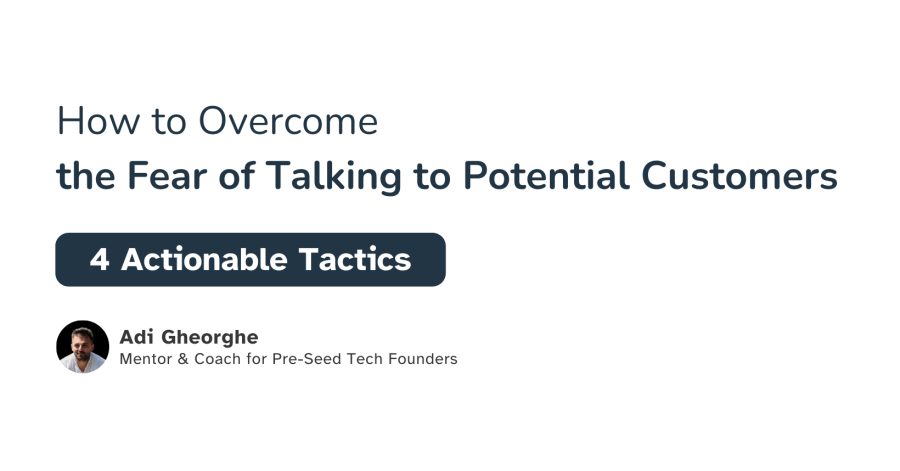One of the main reasons early-stage Tech Founders prefer to build products first and then make the “Great Launch” for their customers is their fear of talking to customers.
And this costs them a lot!
- Months, if not years, of doing only development, without even trying to sell.
- Tons of $$$ & energy lost. (count here also your time that costs $)
- & opportunity cost to build something that really solves a relevant problem.
- All of these will cause you frustration & further problems.
The easy road in the short term is to seek refuge in the comfort of your computer by writing code and refreshing the website.
In this article, I will break down the fear of talking with customers you are experiencing and offer you actionable Tactics to Overcome it.
Main ideas:
- The Importance of Sales Skills for at least one of the co-founders
- Breaking down the Fear of talking with customers
- 4 Tactics to Overcome Your Fears
- Challenge: 90 Refusals
The Importance of Sales Skills for a Tech Founder
It is impossible to be a founder without constantly selling.
- You have to sell yourself and your startup idea to your co-founders. They will have to accept a low to no salary and receive equity for that. They will invest their expertise, money, energy, and everything else with you. So you have to know how to attract them and how to sell yourself.
- You have to sell to your early employees to become part of your team for a low salary + options.
- You have to sell to your business partners that you will be able to pay the invoices.
- You have to sell to your wife, husband, and kids. Convince them that you are okay and that they will be safe.
- You have to sell to your family. Convince them that you are not wasting your life and they must accept your new life journey.
And you have to sell to your customers. Otherwise, there is no business here—only a playground of building products nobody will use.
We can conclude that sales skills are vital to any business.
But let’s talk a little bit about the fear of talking with your potential customers.
Breaking down the Fear of talking with customers
Most founders are attaching their self-worth to the outcome.
Fear comes in the form of Questions addressed inside your head:
- How will this make me feel when I’m doing this outbound work?
- How will I be judged?
- What will other people think of me?
- What if someone gets mad?
- What if I don’t know what to say?
- What if I’m not the right person to do this?
You are not afraid of failing.
You are afraid of what other people will think of you if you fail.
But if you’re afraid of that, imagine what they might think of you if you aren’t even trying.
Understanding the potential Causes of your Fears.
- Parents or colleagues who didn’t help you too much in building trust in yourself.
- Or worse, Parents or colleagues who destroyed the trust left in yourself.
- Major failures in the past were the seeds of doubting yourself constantly.
- Major emotional failures in the past in love or friendships. Betrayal or having toxic relationships.
- & there are more. These are just a few examples.
The results?
- Personal insecurities, you feel the impostor syndrome.
- You don’t trust what value you can offer yet.
- You don’t believe too much in your idea.
- You don’t trust in yourself.
- You constantly fear what others will think about you.
- You constantly seek validation or avoid conflicts.
And it’s totally ok to experience part of or all of these. We are humans, after all.
But,
You are a Founder or a future Founder,
- Which means you want to build VALUE for someone.
- You want to solve painful problems for someone.
- You have good intentions.
- You want to contribute and bring value to other people’s lives.
You know what you have been through and the obstacles you have passed. Life is sometimes not so easy for founders, but pain and difficulties can only make us stronger.
The road that made you arrive here as a founder is your reality.
The fact that you want to contribute, help, and support others is a virtue!
We need more people like you in this World.
Tactics to Convert Your Fears into Action
Tactic #1 – Perception – Let’s change SELL with HELP
The harder you try to sell, the fewer clients you’ll get.
Try instead to HELP them. Reframe SELL with HELP in your mind.
Now, put yourself in your potential customer’s shoes.
If you desperately try to sell and see your relationships only with the material eye, how do you think your customers will feel when they talk with you?
How would you feel if someone saw you only as a prospect to whom they could sell something? Do you like those salespeople? Did they earn your trust? Probably not.
This game is all about Trust. You have a problem. I help you solve it. You pay me for that. The payment is just a result of you solving a problem for someone else.
If you constantly focus on a clear agenda to sell and close the deal, basically, you indirectly say to your customers that you are more interested in selling your product/services than helping them with their problems.
And this pushes customers away. It makes them fear and diminishes their trust in you.
At the same time,
It makes you fear and say that you are not made for sales and should go back to developing your product (the comfort zone). But you know you don’t have this as an option.
Rethink the word SELL to HELP. Transform SELL to HELP.
You want to HELP these people if you CAN.
For this, you’ll have to understand
- What is their painful problem? What are their needs?
- How do they make decisions to cover their needs?
- What has prevented them from solving their problem up to this point?
- Have they actively searched for a solution to it? Or is it not that important?
And if You can truly help them, You will.
If not, say you are not qualified for this or overqualified and recommend someone else. This will build trust.
Everything you say or do either loses or gains trust in the other person’s eyes.
What we see in Wall Street movies or on the streets doesn’t work in 2024, especially when you are a tech founder at the beginning and trying to discover the equation of a potential business.
Tactic #2 – Focus on Actions, not Outcomes.
At this stage of a pre-seed tech startup, with revenues between $0 to $100k, we can control only the actions, not the outcomes.
Type of outcomes we can’t control:
- How many appointments can I set?
- How many leads can I generate?
- How many deals can I close?
Example of actions WE CAN control
- Time commitment (I will stay 2 hours a day, focused on contacting customers)
- Or a Contact Goal (I will contact 23 potential customers daily)
The outcomes will take care of themselves if you focus on ACTIONS.
How do I know if I am successful today or failed?
- Have I contacted 23 potential customers or not? It’s a simple answer.
- Have I worked focused on contacting potential customers for 2 hours or not?
Attach yourself to the activity. Leads, appointments, and deals closed will happen after.
Results are a byproduct of focusing on the activity that leads to the outcomes.
And keep in mind: “Success is the ability to go from failure to failure without losing your enthusiasm.” ― Winston Churchill said.
Tactic #3 – Reset your expectations
PLG – Product-led growth is not applicable when you have a tech Startup in its early days.
At first, your sales must be made through one-on-one talks because you want:
- to test your main business hypothesis,
- to test different customer personas,
- to better understand your customers’ painful problems,
- and to discover your Early Adopter – your Ideal Customer Profile.
As Paul Graham said in one of his essays, Do Things that Don’t Scale, First.
So you have to search for potential customers to talk with.
When you are searching for potential customers, we call this “prospecting.”
Prospecting is a process of sorting through the people you talk with until you finally find the early adopters you’re looking for.
Let’s simplify the sales conversion numbers.
The average opportunity when doing outbound prospecting is about 10%.
- Out of 100 people you are contacting (message/email/phone/direct), only about 10% are Opportunities. These 10 are potential early adopters you were looking for who would be interested in having a one-on-one discussion with you.
- In one-on-one customer talks, the average closing rates are between 5% – 15%.
Examples
- From 10, with a closing rate of 5%, it will be 0.5. At 200 contacted, gain 1 customer.
- From 10, with a 20% closing rate, at 100 contacted, you will gain 2 new customers.
- The numbers differ a lot from industry to industry and from the business model b2b or b2c, but let’s keep it simple for today.
The Problem I have often seen at Founders is that they have the wrong references. For example, “I have contacted 10 people, and nobody is interested. We should change the customer profile/pivot, etc.” is wrong. You really need relevant data here, so contact hundreds, and then draw conclusions and make decisions.
You don’t have to convince anyone of anything!
- Your job is to find 1-2 people/day that need & might want your help.
- Your expectations must be that +90% of the people you are contacting will be lost.
- and You will get out of this mindset of forcing everyone to buy from You when they clearly don’t need Your help.
When you try to convince or persuade a potential customer, your customers will resist and put themselves in a defensive position. You don’t want that!
Tactic #4 – Overcoming your fear of selling a non-existing (yet) product.
It is normal to fear making a sale when you actually don’t have the product ready yet. But you have to do it anyway to validate/invalidate your business hypothesis FAST without too many resources spent in the wrong direction.
The best validation is a paying customer. Nothing else can reach this level of validation.
You can make an MVP even through a Google Slides / PDF with the problem, solution, and benefits, present it to your customers, and ask for money.
To diminish this fear, you can offer a Money-Back Guarantee if customers are unsatisfied or if you don’t deliver the promised product/service in the specified time. Doing this might ease your pressure and help you realize that failing in front of your customers is not the end of the world. We all did that! It is a constant learning process.
Challenge: Trick your Brain & Get 90 Refusals / Week
Transform Your Fears into Your Friends.
Put your objective to 90 NOs from your potential customers.
Putting FAILURE as an objective will overwrite your previous mindset that Failure is Something terrible.
You need training and exercise in receiving NOs, objections, and refusals. This is the Way.
The value is in the process of learning and improving.
- It’s ok to fail.
- It’s ok to get many rejections.
- It’s ok that you’re not perfect.
What matters are your good intentions to help someone.
& to LEARN as much as you can from the Process. From the Failures.
Trust the process! There is no MAGIC equation but just work & iterations & learning from them.
Do you know other Tech Founders who might benefit from reading this article?
Share it with them.
This article was written by Adi Gheorghe, with amazing support from Elena Ghinita in collaboration with The Recursive.








